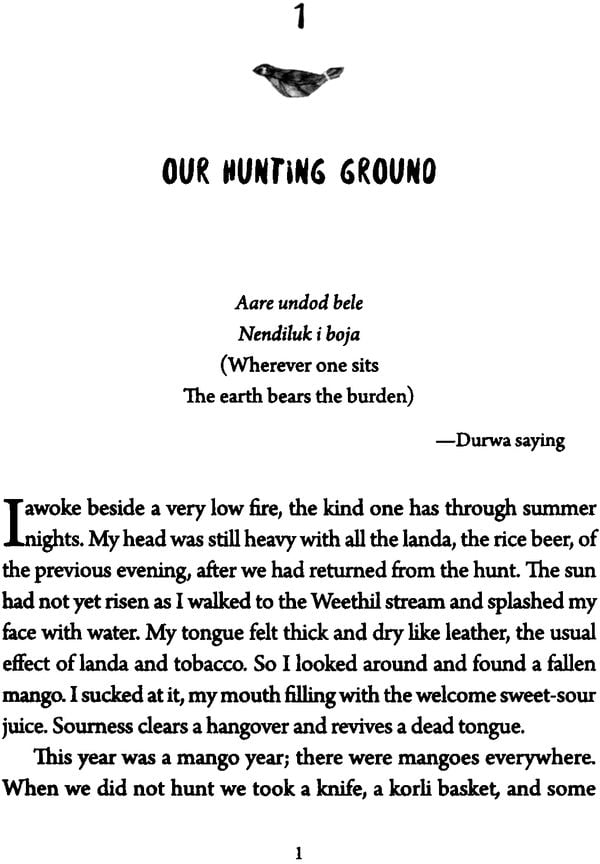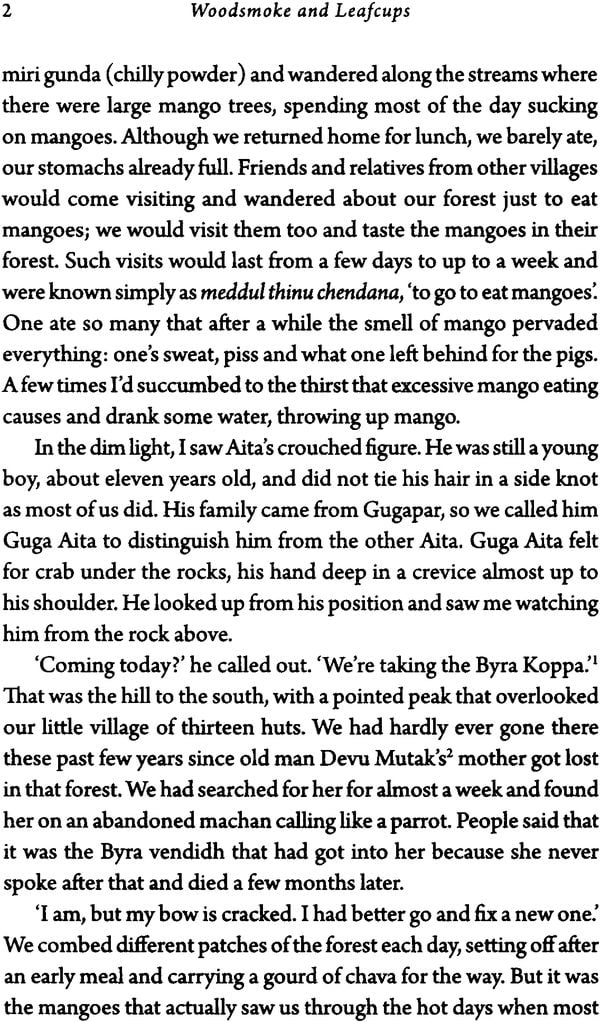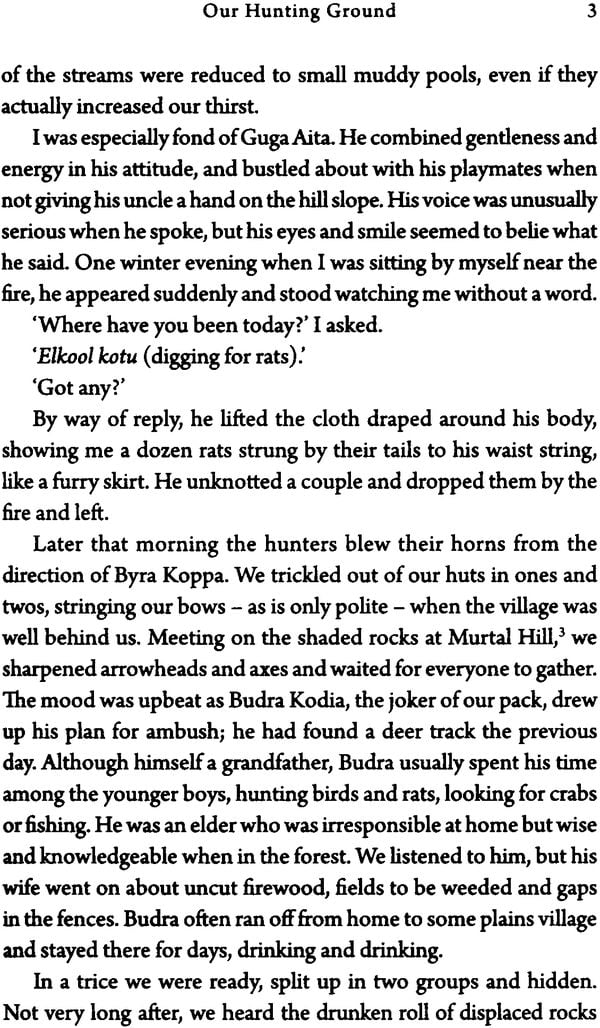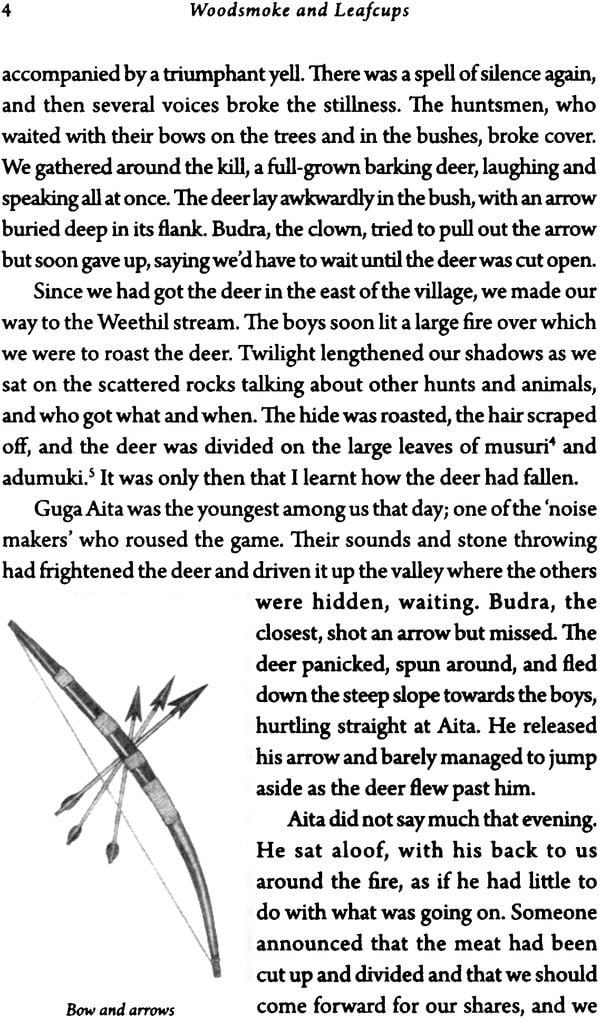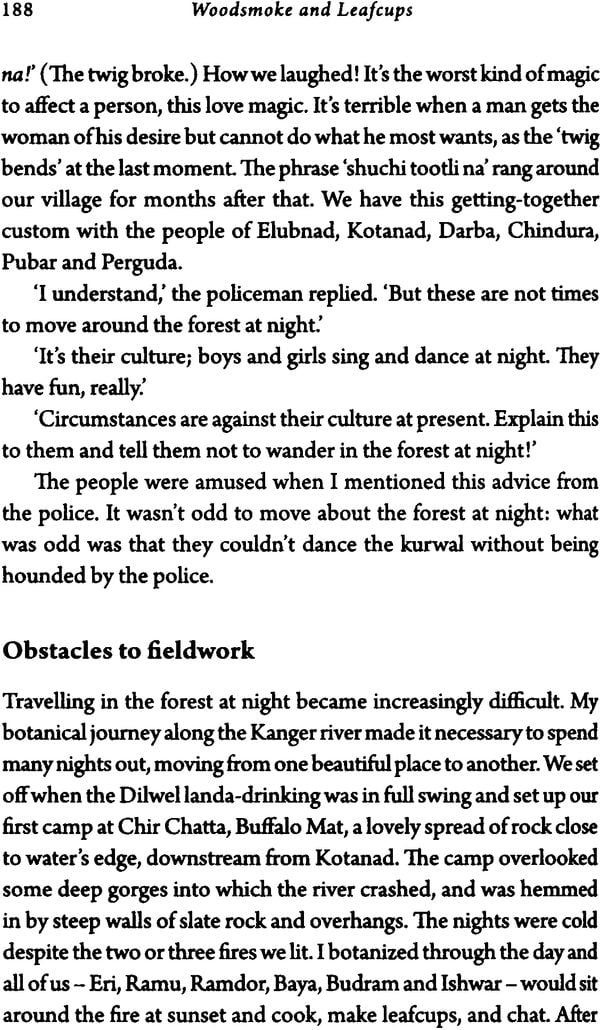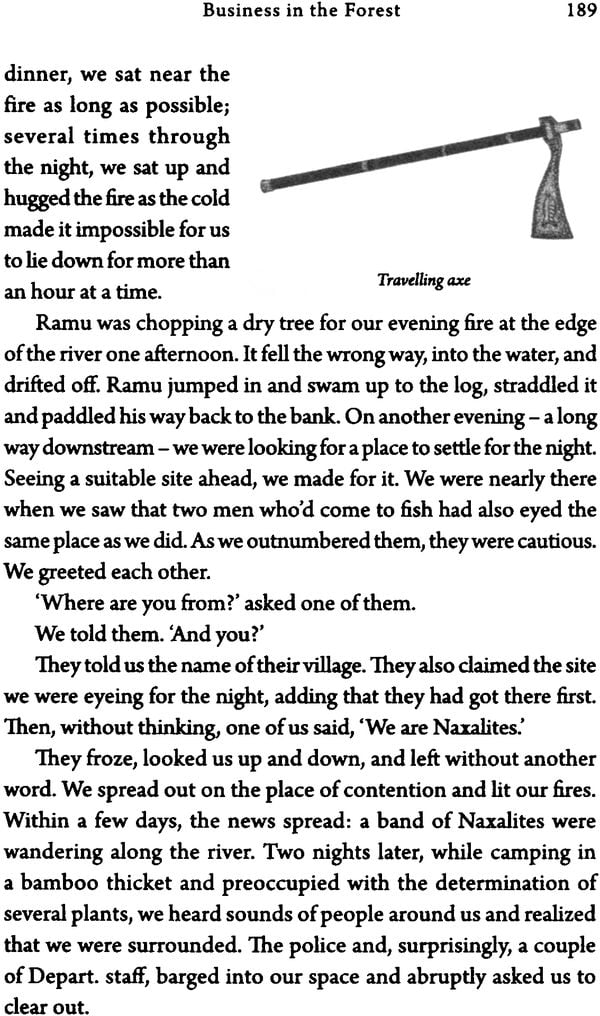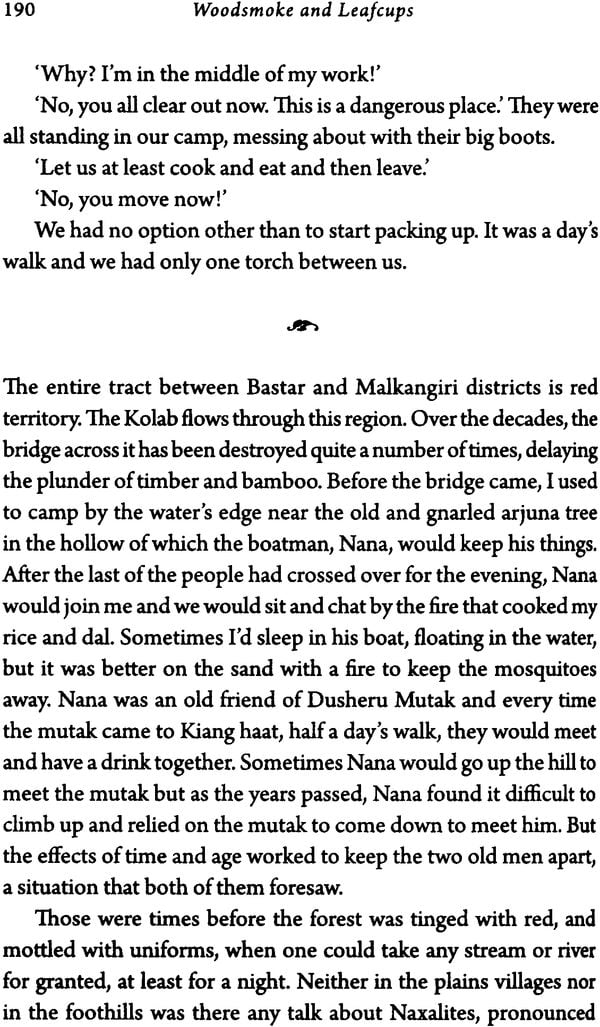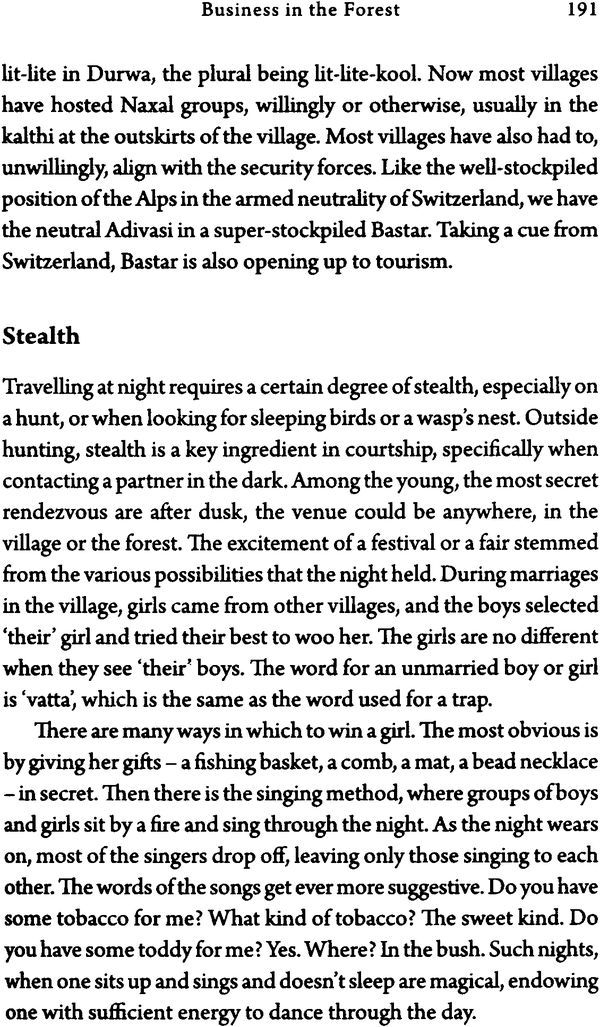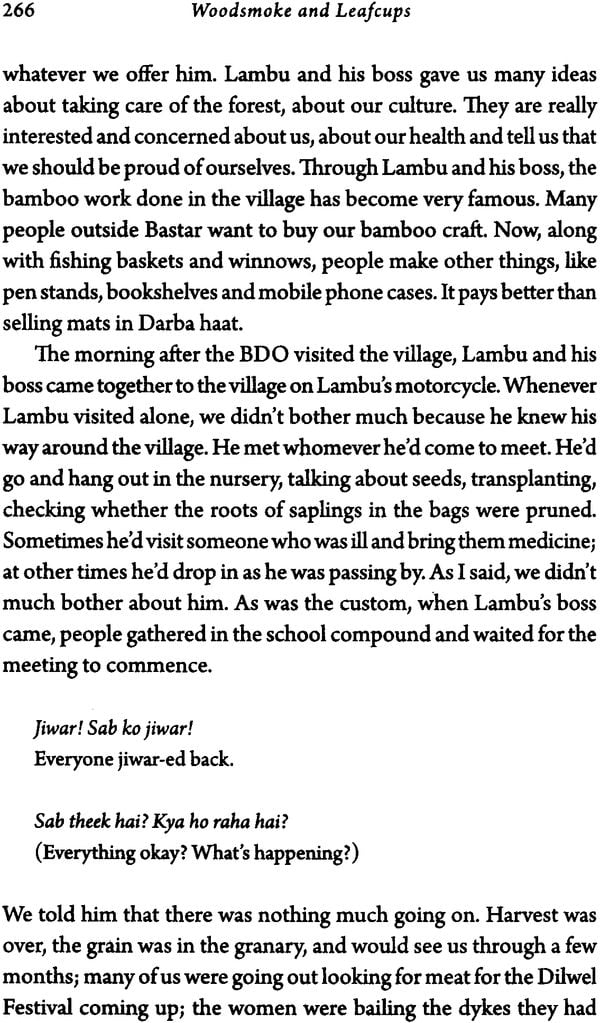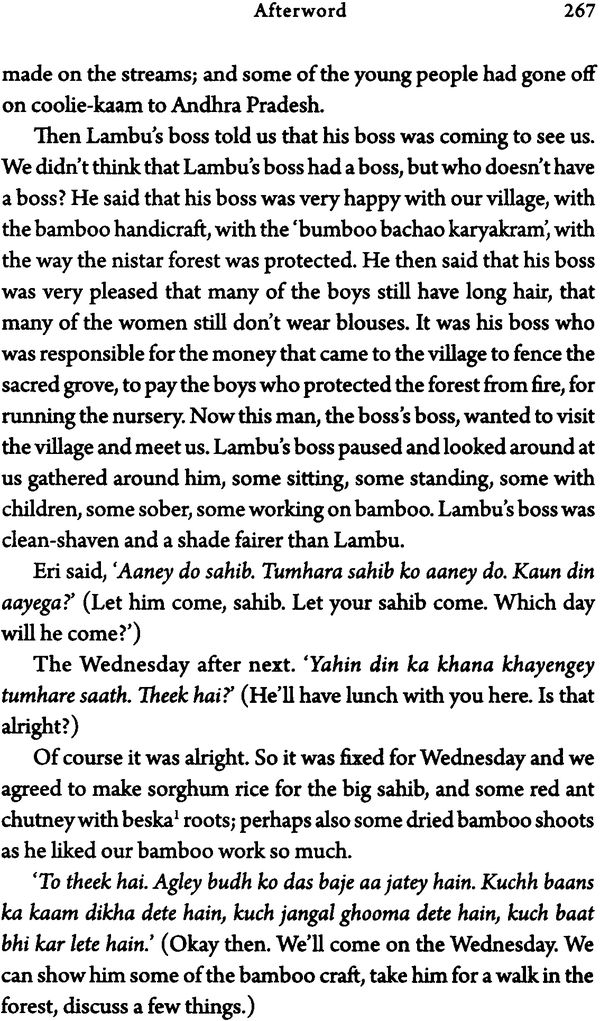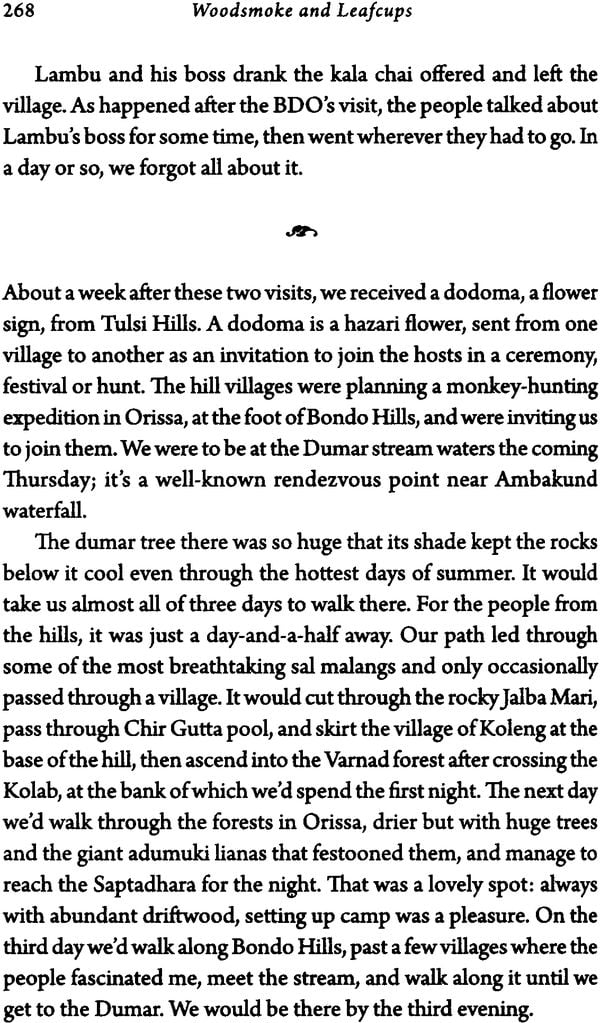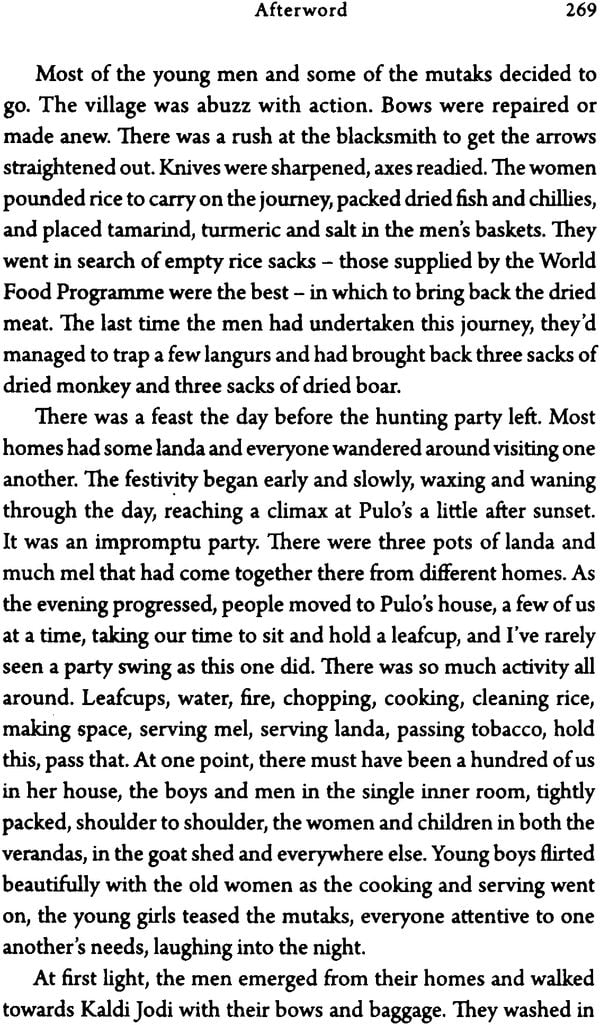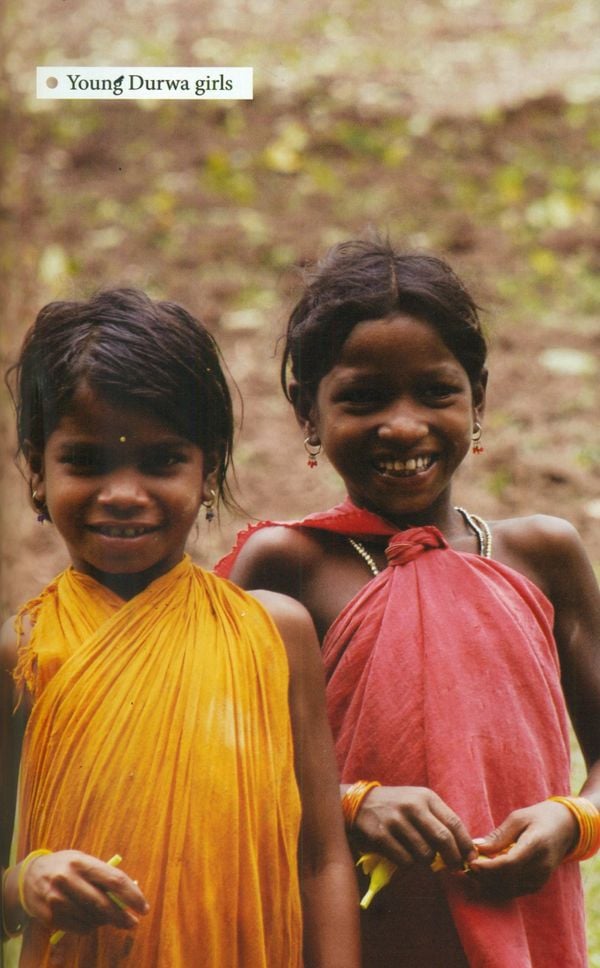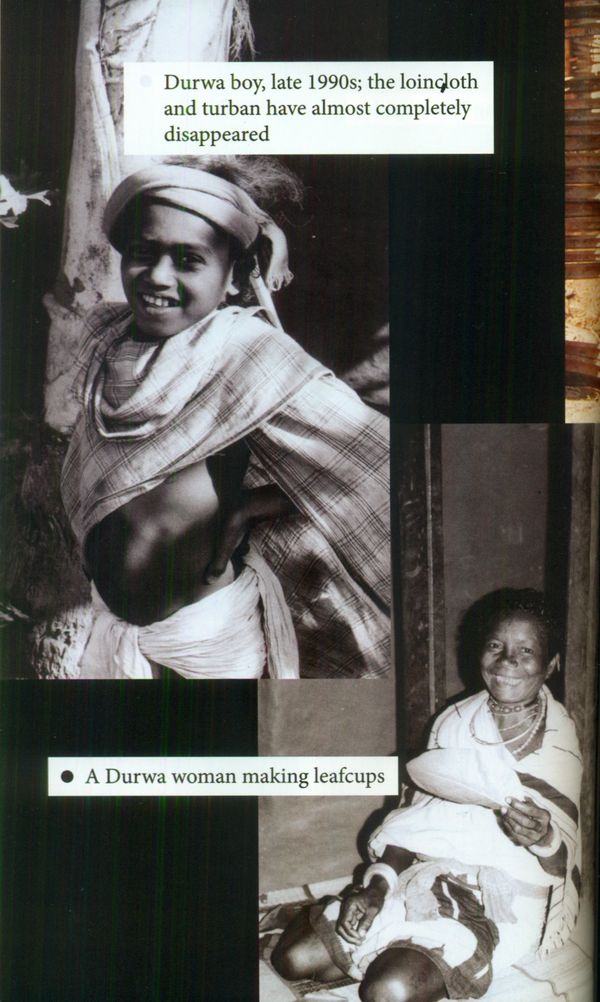
Woodsmoke and Leafcups (Autobiographical Footnotes to the Anthropology of the Durwa People)
Book Specification
| Item Code: | NAL789 |
| Author: | Madhu Ramnath |
| Publisher: | Harper Collins Publishers |
| Language: | English |
| Edition: | 2015 |
| ISBN: | 9789351773184 |
| Pages: | 324 (29 Color and 35 B/W Illustrations) |
| Cover: | Paperback |
| Other Details | 7.5 inch X 5.0 inch |
| Weight | 270 gm |
Book Description
Madhu Ramnath was schooled in Delhi and Amsterdam and effectively de-schooled in Amsterdam and Bastar some years later. A product of both processes, he now lives in Kodaikanal, Tamil Nadu.
Woodsmoke and Leafcups is a first-hand account of life in Bastar: the routines of communal life and the interactions of the Durwas with the State machinery. He writers of a culture where energy and laughter are currency, although of no value to anyone else. He draws a portrait of friends and teachers, threats and ways of eliding them, and the lure of politic for those long indifferent to it. At a time when 'there are few places in which to lose oneself', Ramnath writes of a people and a place that exist outside, sometimes counter to, known narratives.
Madhu Ramnath spent thirty years with the Durwa people in Bastar. What as impulsive travel to a swathe of land that had road criss-crossing it soon turned into a homecoming: each stint in the forest compelled him to return and, finally, to stay. Over the years he becomes a student of Durwa life, living in the forest, tending cattle, working a hill-slope in the village. He immersed himself in the Durwa world while indulging his passion for devising a botanical classification that would be accessible to a layperson.
Powerful, elegant and important – this is a book that takes us to the daily life, intimate preoccupations and the most urgent challenges deep in the forests of Baster, in the very heartland of an Adivasi world. In these beautifully written, poignant and compelling narratives, Madhu Ramnath shares with us his own immersion in that world. He writes with remarkable lightness of touch, with great humour and compassion; yet reveals an encyclopaedic knowledge and understanding of both the natural and social world to which he leads us. The book reveals both what it can mean to be human, and how much of humanity is at terrible risk.
In these wonderful stories, the careful balances of Adivasi life are shown again to be the mercy of the powerful and the corrupt representatives of an alien and dominant state. Here is a book to delight in, be inspired by and learn from. Every part of it sends out a vital message. In the stories, rituals, songs and everyday realities of the peoples who have lived since time immemorial on their lands in those forests, in all that Ramnath has experienced and now describes, may lie much that humanity both years for and needs. And that could all too easily be lost. So much of life in the forests we enter is rich with meaning and beauty and laughter; all of this is at risk.
This is a book for everyone who seeks to know the world, for anyone who cares about the heartland of humanity, and for who would wish the world to save itself from mindless and destructive indifference to both forest and the people who know the forest best. It cries out to be read us all. All who read it will be enchanted.
The beginning
One summer, about thirty years ago, I spreads a map of India on the floor of my room at university. A large swathe of the country in central India was conspicuous for the paucity of roads criss- crossing it. Delighted with this discovery, I decided to go and explore that part of India, spread across a large area of erstwhile Madhya Pradesh, Andhra Pradesh, Orissa, and Maharashtra. Little did I then realize that I'd embarked on a journey that would span several decades; one that would transform the way I saw myself and provide me with another vantage and perspective from which to view the world.
My first trek began from a small town called Bijapur, the outskirts of which merged with the forest, from where I drifted roughly a south for about two weeks towards Bhadrachalam. Along the way, I met and lived with Adivasi people – principally Dorla and Dandami Maria – who took care of me, giving me my first glimpse of how life could be lived. Clearly, I'd been seriously off the mark.
Brief stints in the forests fed a desire to remain there. As soon as I was through with college, buoyed by youthful exuberance and impatience, I turned my back on both university and city and headed for Baster. I found shelter and a vocation in one of the hill villages that bordered Oriss and, among other things, took a keen in plant identification. I spent my youth exposed to pleasures and pain of a kind that confirmed something I couldn't lay my finger on. Bastar remained outside the country I knew and with I was familiar: the scent of sal hinting at something more refreshing than the goals to which India aspired. As Lucretius remarked of early mankind, everything was new and marvellous. Energy and laughter were the currencies of this new land, and the beat of a drum its pulse. Not many recognized the worth and genuineness of these currencies, tested by time and lamented that the Adivasi continued to be 'race that had no use for the copper coin'. I became a student of Adivasi life; the village and forest became a place of learning, everyone I met a teacher.
The contents of this book have been gleaned from the notes I maintained over the past thirty years, supplemented by memory. The latter plays trick, alters perspectives of events over time, but what seemed important then I continue to hold to be important today, in a world becoming increasingly cramped and one in which there are few places in which to lose oneself.
The Landscape
The greater part of Bastar is a tilted peninsular plateau, varying in elevation between 284 and 1,200 m. Uninterrupted denudation over millions of years has grievously dissected this plateau of ancient crystalline rock marked by river valleys and flood plains with relict uplands, hills and mountains. The principal rivers of the region are Indravati and Sabari, both tributaries of the Godavatri in the south, the largest of the rivers flowing west to east in the region. Winter nights can be extremely cold and most Adivasi homes get by with a fire to sleep beside. Summer is hot, sometimes sufficiently so to cause stands of sal trees to dry up and die.
A ways of life
I maintained, to the best of my ability, a Durwa lifestyle over many years. A preoccupation with plants came early, with most conversations, ever casual ones, such as indicating direction in the forest, entailing some reference to them. Moving around the forest with my companions made clear the advantages of being unshod and minimally clad; it was imperative that I be an asset and not a burden in a food-collection expedition if I wanted to be part of it. Fishing, gathering and hunting excursions were learning experiences as much as a way of life. Coming from a softer society, where money smoothed most paths, I struggled and stumbled through my lessons for some years until the pursuits paid off, the body as well as the mind adapting to what was present and immediate.
Land and people
Most agriculture is rain-fed, depending upon the south-west monsoon. July and August are the wettest months, accounting for over three-fourths of the season's rain. People get their ploughs and spades ready and mend their fences when the nowdeli begins to bloom; harvest nears completion by the time the large nephila Spireds weave their orbs across forest trails; when wild boar begin to dig up the roots of thummi plants. A season of festivity then commences, through a brief spring and into a long summer. People travel to meet relating at the village shrines. Many of the journeys are one foot, sometimes with a night en route, each a pilgrimage and a tale in itself.
However, important as agriculture is, it is the range of wild foods that people consume which down them with their independent disposition. There are over 500 species of plants and animals that the adivasi procure and judiciously manage. In villages at a distance from the roads, where sizeable forests continue to thrive, the people are healthier than their relative who in the proximity of towns. Until the late 1980, stitched cloth did not exist in most villages; most men wore a simple a simple loincloth that sufficed to enable them to conduct the daily Business of life. On formal occasions, a longer and wider piece of cloth was worn could be wrapped around like a skirt, with a tail sticking out. A woman's luga was barely more than five hands long, wrapped essentially around the waist and above the knee, stylishly knotted at one shoulder; it did not hinder her climbing a tree or springing across a stream. A society's self-reliance is usually in inverse proportion to its reverence for the state. In some inexplicable ways, the adivasi of the deep forest showed his disdain for the sahib by wearing less the threshold of shame increased as one neared the towns he showed less of himself.
My time
Reflecting over the time I spent among the Durwa people, I recognize two broad, distinct phases. The first, an uncritical acceptance of all that was said and done by the Adivasi people, focused on physical endurance. The second phase came after a decade of acquainting myself with Linnaean and Adivasi botany, and a simultaneous mastery of the language; both these interests were born out of close relations with people in a few specific families. A word about botany is relevant here. I realized quite soon that most botanical works which I used in plant determination were written, implicitly, for botanists and not for laymen like me. It became self- evident to anyone who spent time in the forest that most tress were without flower or fruit for a major part of the year. This notwithstanding, most floras begin with something like 'seed sub cylindrical with a truncate apex, brown', or something a touch friendlier, like 'calyx-winged or keeled, mouth oblique'. How was one to look at a seed or calyx on a flowerless plant? Of what use were those weighty volumes before determination? Or were they intended to be used only to confirm a find? I plodded on, regardless, encouraged by the knowledge that, if Adivasis did not bother with truncated seeds and anther and stamen counts before ascertaining the identity of a plant, there might be equally valid and alternative ways of understanding the plant world.
After almost a decade of dabbling with plants in this way, while also herding cattle and lending a hand at cultivating the hill slope of my host, I realized that it would be a wonderful idea to devise a vegetative key for the plants of the region. This would mean having to look more attentively at the bark, the texture of leaves, the size and thickness of petioles, the angles of branches as they spread out from the main trunk, all of which collectively give a plant its very unique character. The task entailed a search for a teacher interested in and knowledgeable about tropical flora, willing to teach and guide a non-botanist towards a vegetative key. A simultaneous passion that developed during those years was the question of the origins of cultivated plants, an are of thought I encountered in the writings of Alphonse de Candoll. I decided to travel to a few beyond India and examine this aspect. All this broadly transpired during the first phase, roughly between the late 1970s and '80s.
My quest took me to Hortus Botanicus in Amsterdam, one of the loveliest cities in the world. In the centre of town, like a jewel, was the botanical garden. I met the botanist of the garden, Bob Ursem, and explained what I was after: a quick and easy method to identify tropical plant families in the forest. He listened and sympathized with my criticism of the useless botanical tomes I'd spent time with suggested that we work on a vegetative key together for the plant families in Bastar, enquiring (to my wonder) whether we could begin the following week. Bob taught in Dutch, and an understood precondition of my studentship was that our communication would be in that language. We worked most mornings together in the garden before it opened to the public, and noted down the unvarying vegetative characteristics of particular plants that identified a family.
As I was neither on scholarship nor sufficiently wealthy to be financially independent, I needed to earn some money alongside all this. So I painted houses and straightened out a few Dutch gardens. Of the houses I painted, there were two I won't forget; they beloned to two old ladies who had spent time in Auschwitz when they were in their twenties. Edition translated psychological literature from German to English and she had met her friend, Thea, n a chess club one summer afternoon. It had been rather warm and Thea had rolled up her sleeves, unintentionally disclosing her forearm with a tattoo from the camp. Edith had gone up to her and rolled up her sleeves too, and they became friends. It took me a few weeks to finish painting their homes, and while on the job, they took me out for dinner – I had a lady on each arm – to the red-light district where they knew a place that served excellent wine. We drank and chatted until late and I was struck that, despite the horrors that they had experienced, which hey insisted on describing in graphic detail, they appeared completely free f rancour towards the world. The skewed Dutch vocabulary I picked up in the course of these experiences enabled me to hire a scaffold more easily than to ask for bread; to discuss the arrangement of ovules within an ovary more effectively than the weather. Above all, I was extremely fortunate to know Elly, a paediatric nurse whom I had met several years earlier, who supported me in more ways than I can express, and who would later marry me and follow me to Bastar.
I had lived in a fairly remote forest village for about a decade when Elly joined me. With her I moved to another villaged that was a little larger, and also a little closer to the town, in the same tract of forest. Thought we lived together in Bastar for long periods of time, there were also spells when I lived alone. The present narrative is, in many senses, a collation of incidents that occurred in both the village that were home to me, some during Elly's stay and some in her absence. I mention here inly a few events that pertain directly to Elly but there are several other that need to be told, and told by her.
After exhausting the garden in Amsterdam, Bob Ursem and I visited other gardens, herbariums and libraries in Europe. We were fast becoming obsessed, but eventually, we were also able to see the end of tunnel. Over the twelve years that it took for the vegetative key to evolve, we had established a small herbarium in the attic above Bob's room. I'd even brought seeds of some of the plants difficult to identify and grew them in the greenhouse.
I saved enough money to head for the Tehuacan Valley, a dry region of Puebla in central Mexico, the birthplace of cultivated maize and frijioles, the staple food of that country. The very names for maize in Nahuatl – nopayo, milpa, imili, yelotl, cintli, tlayoli, mazorca – intoxicated me with their sounds. Other words in that language, like chocolatl (for chocolate) and avocatl (for avocado) which the Spanish adapted to their tongue, provided me with a glimpse into the role of etymology in tracing origins. Much of my time in mexico – about six months – I worked as a farm hand for an old Aztec couple in a fairly remote farm some distance from Amatlan in Morelos, in the shadow of the hill called Tepotzlan. I fetched water from a pool in a deep gorge, trapping the container to my forehead and climbing up, chopped wood and helped tend the maize and pumpkin patch. In the evening I would sit with Don Emilio and Dona Catha, my hosts, and watch the evening star – Emilio called it Estrella de Quetzalcoatl – low on the horizon. He was ninety- three years old and claimed to have fought alongside Emilio Zapata in the 1910 Mexican revolution.
Medicine and healing
The second phase began when I returned with Elly to Bastar in 1991. I became aware of the medical needs of the people; a new world opened up and our days began to be increasingly full. Typically, a day would begin with the first patients visiting us before 8 a.m. By then Elly would have swept the fireplace and plastered it with a paste of cow dung and earth – a chore she intensely disliked; to this day, she continues to wonder at the logic that uses dung for cleanliness – while I kept out of the way, hanging out with the youth who all came with little babies on their hips. When the home was ready for her patients, I'd cook and simultaneously translate for Elly and the patients. During the first months, Elly mastered the words for illnesses in Durwa, the most common ones being noikud (pain), gawa (wound) or potta (diarrhoea), and some of the idioms such as 'my heart feels like a banana leaf' signifying weakness and dizziness, and other poetic description like 'I have a duck stomuch' to describe gastroenteritis. After the last of the patients of the morning had left, we'd eat and set off into the forest with a couple of companions in search of plants and the elusive botanical key that I was after. Some years later, our son Wytze was born and Elly stayed back in the village while I botanized alone.
No day was ever predictable, though. One rainy evening, after most of the patients had left, I saw a couple of boys waiting for us. Elly was tired after a long day of attending to patients – in the main, victims of malaria and diarrhoea – and asked them if they could come back the following day. They said they would, but requested Elly to have a look at their problem first: if it wasn't serious they would return in the morning. In the dim light, an umbrella sheltering him from the rain, the boy removed the blood- stained cloth with which his thigh was covered. We saw that the flesh had been torn from a little above the knee to halfway up the thigh, exposing a pale femur. Elly could not believe the calm expression that belied the seriousness of that wound. The boy had gone out to hunt and had been gored by a wild boar. I was promptly sent off to fetch a few bottles of mahua to be used as an anaesthetic and Elly busied herself with getting the necessary material together. I brought the mahua, and after the boy had consumed sufficient quantity of that magical drink, Elly began to painstakingly clean and stitch up the wound. The boy's companion and I umbrella and torches throughout the operation. A few times she ran out of thread and had to rummage in likely places, find bits of it, and continue. Her patient looked away into the darkness, his face expressionless. He was asked to have a look at his leg after it had been bandaged; he did so and rewarded us with smile that broke out across his face.
On another occasion, when the river between our village and Kotanad was swollen, we heard that a woman had slipped and fallen on a rock and split the skin over her knee. Her people came over to fetch Elly and asked her to stitch the wound; this would take a few days of treatment. Wytze was still a baby then, which meant that her visits across the river were timed between two consecutive feeds. She'd feed Wytze and wade or swim to Kotanad with an escort and return home before he went hungry too long. I'd wait with him and hope that the river didn't prevent her from returning home by evening.
In our initial years we encountered a spate of sexual diseases, especially among the youth. Usually, it was the girl or woman who would come to Elly and explain her problem – the external symptom of the disease – and seek treatment. It was difficult to convince her that the real problem was an internal one and that the treatment would necessarily involve her partner or husband and that she would have to bring him to us too. Notwithstanding the embarrassment that surrounded this malasy, our efforts – and the understanding that we remained silent about who came to us with such problems – began to pay. In a couple of years, sexually transmitted diseases were rare in our village and most boys carried condoms when they visited a fair.
Through all these medical interventions we remained oblivious to the 'political' implications of our presence. It was only much later that I realized that even administering a pill of paracetamol was politics in India, and that we were treading on sensitive toes. Our presence and the people's response to us – they came from village as far as 30 Km and camped around our home as long as the treatment lasted, and finally I had to build a separate shelter for hem – was not well received by the local medical officers. Sometimes even local policemen and nakadars would come to Elly for medicine – an ironic reflection on government dispensaries and those in charge of them.
A personal perspective
This was a period of a lively interaction with my teachers, encompassing a wider range of interests, which I'd like to believe, encompassing a wider range of interests, which I'd like to believe, was mutually uplifting, In some villages I was invited to sit in the councils that discuss matters of common concern, especially when the concern came from without. These exchanges and dialogues continue today with the new generation, many of whom are the children of with first befriended me and took me into their home and hearts.
Many of my actions, both of omission and commission, will show me up in an unfavourable light judged according to the rules of modern society. An obvious instance is my participation in many hunting trips. Rather than making an effort to dissuade my companions from going out for meat, I chose to go along with the reality of the present, and more or less successfully, resisted the temptation to interfere. My role has been that of a student and a witness not that of a social worker or a obliged to a department or institution that studies or tracks Adivasi society.
The freedom to live as I did, accountable to no one but myself and to the people with whom I lived, came when I was asked to tend the herd of village cattle. It was a small village of about seven or eight households and I was fed well for my services. Four of us from a couple of households took out the cattle day; in the evening we'd go to the homes that were ours and collect food. There are no better ways of acquainting oneself with the terrain around a village than taking the cattle out to graze. Regardless of the season, most of the day was spent outdoors, venturing to places most people rarely visit.
The contemporary discourse about the people of Bastar is confined to their plight in the hellish conditions that prevail today. The urgency and attention violence demands relegates all other interests, be they linguistic, musical, or botanical, to an anachronism. Little of note and quality on the Bastar Adivasi has appeared since the writings of Elwin and Grigson. The state has on occasion been proud of its indigenous populations, showcasing them through their Departments of Tourism, like museum pieces, literally and shamelessly encashing their uniqueness, rather than attempting to emulate even a fragment of their lifestyle. On a people who are, in the main, self-sufficient in terms of natural resources and character, the state showers an array of welfare schemes, few of which are implemented and followed to their logical ends. Between the gentlemen in the capitals responsible for these schemes and the officers in the field obliged to fulfil them, there is an immense gulf, the result of which is that the state in its various avatars is the nemesis of the Adivasi. Uring the state elections in November 2013, the most courteous and cultured of regions was turned into one of the most militarized places on earth as an ode to democracy.
Much of what has been written about Bastar and tribal India in the past couple of decades tends to build a case for change. Indeed, although change. Indeed, although change seems inevitable, the justification is narrowly economic and political. It is the nation's mindset that people who consume little and contribute even less to the GDP are not important; that they may b dispensed with or, at least, moved out of the way of those who seek progress. I met a collector in Bastar a few years ago. He's an upright and honest man, respected for his efficiency, who believed – as do political leaders – that the region should be 'opened up' to factories and other large development projects. To elucidate his view, he said that 'the people should learn to envy their neighbour; that's the only way they strive for more'. Daunted by this simplistic thought, I asked, 'What if the Adivasi people are satisfied with the life they lead; if don't want to give up their land? ' The collector said that the state would endeavour to explain the situation to them, of the urgent need for progress, and offer them fair compensation for their land, perhaps even plead with them; but if they still resisted, the state would have no option other than to grab them by the scruff of their necks and expel them. This man saw himself as an understanding and compassionate mediator paving the way for the progress that would ensue.
The natural wealth with which much of tribal India is endowed is also its bane. The erstwhile Bastar district, one of the largest in the country, was first divided into three, and later into seven parts, each with a separate administrative system. In the guise of bringing governance closer to the people – let us, for convenience, assume that the Adivasi people crave governance – corporate and bureaucratic channels have been efficiently established, and lead to the mineral-rich hinterlands. The abundance of timber and other forest riches that attracted the initial adventurers into this little-known region – the palatial mansions in Jagdalpur and Kondagaon are testimony to their success – is insignificant in comparison with what is now possible. Much still remains to plunder and it matters little whether or not it is done officially and legitimately. What is crucial is that the need for the plunder has been implicitly agreed upon as unavoidable if we are to forge the route to progress.
The Adivasi is wedged between the state programme for development, meaning mines, dams, steel plants and roads, and a private agenda for quick money, which is currently termed 'real estate'. The Naxalite presence in this scenario has raised the levels and incidents of violence. The incredible amount of weaponry now available in an otherwise peaceful land has injected a definitive element of fear in the villages; it has spread like an invisible shadow, unseen by those in control but painfully tangible to the Adivasi. It is a fear concocted by a mix of contrary ideas and policies about sharing the cake, discussed through arms and violence, and invariably leading to more arms and violence. The fear has pervaded homes and families, and cast brother against brother, destroyed the trust between friends, an ailment more severe than that achieved by the combined forces of missionaries, traders and an apathetic administration over the past century. Even optimism has its limits.
Where then is Levi Strauss's vision of freedom, when 'man would finally be freed from the obligation to progress, and from the age-old curse which forced it to enslave men in order to make progress possible'? When will history 'be quite alone, and society, placed outside and above history, will once again be able to resume that regular and quasi-crystalline structure which, the best preserved primitive teach us, is not contradictory to humanity'? In these times when cultures and ways of life are being blown away like dust in the wind it is hoped that such a narration of an Adivasi lifestyle may offer us a possibility. Progress is about keeping options open, not foreclosing them.
| Foreword | xv | |
| Preface | xvii | |
| 1 | Our Hunting Ground | 1 |
| 2 | Enter: Forest Depart. | 16 |
| 3 | Dreams, Illness, Messages and Magic | 25 |
| 4 | Predicting Rain and Gathering Firewood | 55 |
| 5 | Of Policemen and Other Law-keeprs | 68 |
| 6 | Death and Its Rituals | 86 |
| 7 | Of Cocoons, Containers, Land and Politics | 98 |
| 8 | The Night of the Mutak | 114 |
| 9 | The Department of Mysteries | 125 |
| 10 | Welkel and Other Festivals | 131 |
| 11 | Monsoon Occupations | 146 |
| 12 | Intoxications | 161 |
| 13 | Business in the Forest | 181 |
| 14 | Children | 199 |
| 15 | Food and Identity | 210 |
| 16 | The Depart. And Village Councils | 221 |
| 17 | Uniforms and a Reign of Fear | 245 |
| Afterword | 263 | |
| Notes | 271 | |
| Glossary | 278 | |
| Acknowledgements | 290 |
